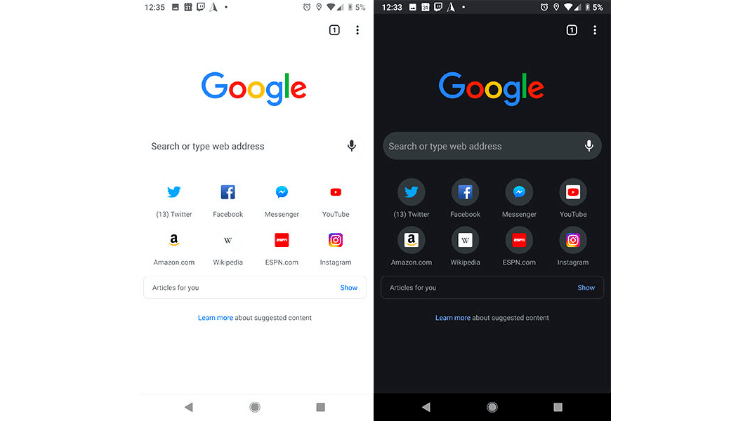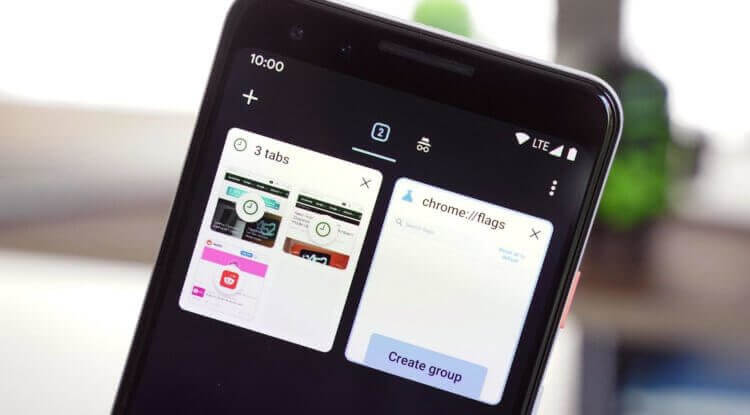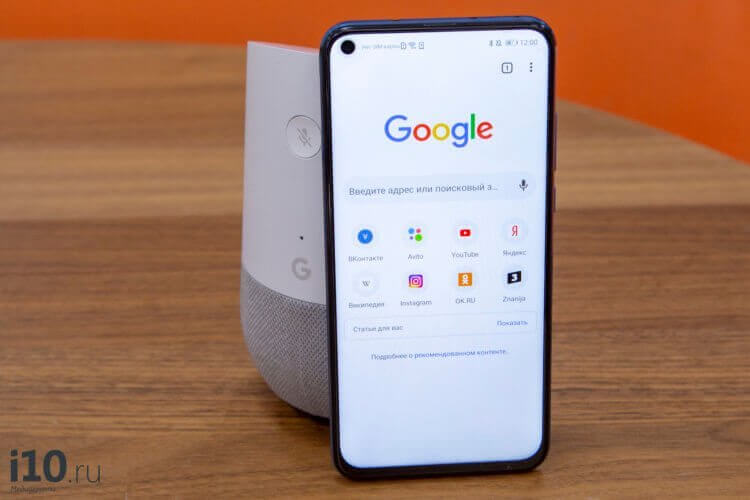I have already given examples of browsers for Android. There are so many to choose from. Although, many are built on the same engine and because of this they differ little, except for the location of the controls. Now we will talk about one browser, but it is he who has so many little-known life hacks that there is definitely something to tell. Moreover, this browser is used by almost all users Android, and it is installed out of the box on their smartphone, except for Huawei and Honor. There are probably a couple more manufacturers that can be neglected. I mean Google Chrome.

Google Chrome is cooler than it looks
- Hidden features of Google Chrome
- How to enable dark mode in Google Chrome
- Getting notifications Facebook and Twitter in Google Chrome
- Fast tab switching
- Try Chrome Duet
- Saving site pages
- Quickly close Google Chrome tabs
- How to add or remove a home button in a browser
- How to save a website in PDF format
- How to enlarge text on any site
- Searching a page in Google Chrome
- How to disable or enable notifications on the site
- How to mute website sound in Google Chrome
Hidden features of Google Chrome
Chrome is Google's globally popular browser platform, and while the Android version may not seem as powerful as the full desktop version, it actually has a ton of hidden features. Some of them can speed up switching between tabs or improve performance on an unstable Internet connection, but there is also something else.
In this article, we'll go over 12 tips and tricks for using the Google Chrome browser at Android.
How to enable dark mode in Google Chrome
In Android 10 Google Chrome supports dark theme and can change it according to system settings. That is, adjust to the general theme, but in earlier versions, themes can only be switched in the 'Settings' section. Click on the menu button, select 'Settings', then click on 'Themes'.
Switching Chrome to a dark theme darkens not only the app's interface, but also websites dark if they have a dark theme. There is also an experimental feature that makes all sites dark when dark mode is enabled.

Dark theme is always good
Just copy and paste chrome: // flags # enable-android-web-contents-dark-mode into the address bar and set the dropdown menu to 'Enabled'. If you want to disable it later, just go to the same address and set the value to 'Default'. (all actions you perform at your own peril and risk).
Getting notifications Facebook and Twitter in Google Chrome
The app Facebook for Android has always left a lot to be desired, and it might not be a good idea to install it given the privacy history of Facebook. The Twitter app is less awful, but if you don't use the service often, you might not want the app to take up memory and drain your battery in the background. Fortunately, you can receive notifications from both services via Chrome.

Facebook to Android is not the best app.
For Facebook, log into the site on your device, click the menu icon in the upper right corner of the page and scroll down to 'Account Settings'. Then click on 'Notifications' and click on the 'Enable' button.
For Twitter, go to mobile.twitter.com and click on the notification button. You should see an option to enable push notifications. If not, click on the settings button in the upper right corner, select 'Push Notifications' and then click on 'Enable'.
Fast tab switching
The most obvious way to change tabs in Chrome, which everyone uses, is to click the tabs button and select the one you want from the list. But there are two other ways to change the current tab. You can swipe left and right across the address bar, or swipe down the bar to see the full set of tabs. Swipes are our everything!
Try Chrome Duet
Google has been working on an update to Chrome's interface called 'Chrome Duet' for a while. Instead of a single address bar at the top of the screen, Duet keeps the address bar at the top and moves frequently used functions to the bottom bar. However, Duet isn't available to everyone yet, so you'll have to enable it using the Chrome command.

Someone is more comfortable when the controls are at the top, and for someone when they are below.
To enable Chrome Duet, copy and paste chrome: // flags # enable-chrome-duet into the address bar and set the dropdown menu to Enabled. If you want to disable it later, reopen that URL and change the dropdown to 'Default'. (remember that everything is at your own peril and risk, huh?)
Saving site pages
If you need access to a specific page but have an unstable connection, constantly pressing the reload button to get the information you need can be a little annoying. Fortunately, Chrome offers a solution.
When you are offline, just go to any page (by clicking the link or typing it into the address bar) and click the 'Download on connection' button. Once you connect to the Internet, Chrome will save the page and notify you.
Quickly close Google Chrome tabs
If you want to close the current tab without opening the tab overview, there is a faster way. Hold the tab button for a second and you will have a menu with the option to close the current tab.

Tabs have always been controversial. Whether they are needed or not.
In the same way, you can create new tabs using this method, but it will not be faster than creating tabs through the normal menu.
How to add or remove a home button in a browser
On some devices, the Home button is visible in Chrome. This is because some manufacturers include the 'ChromeCustomizations' APK in the system folder, which sets the default values for bookmarks, including the Home button. But if this APK is missing on your device, there is a way to add the home button (or remove it if you don't need it).

This button is more convenient for me personally.
If you don't already have a Home button, paste chrome: // flags / # force-enable-home-page-button into Chrome, select Enabled from the dropdown menu, and restart the app twice. You now have a home button! You can change the address to which it will lead you by going to Settings, then Home page, then Open this page.
If you have a Home button in Google Chrome and want to get rid of it, just open Chrome Settings (menu button in the upper right corner, then Settings), click Home and turn off the switch. Very simple.
How to save a website in PDF format
As mentioned above, Chrome allows you to save pages to your phone for offline viewing. But what if you want to send the saved page to someone or save it in your downloads folder? By combining Chrome's sharing feature and the Android 'Print to PDF' feature, this can be achieved without any additional tools.

There are applications that create PDF, but it can be done using regular tools.
Find the page you want to download and then click the Share button in the main menu. Select 'Print' from the general menu and change the printer to 'Save as PDF'. Then just press the blue button to download the file. Since you receive the PDF, it can be opened on almost any computer, phone or tablet.
How to enlarge text on any site
In many cases, mobile-optimized sites do not allow the user to manually zoom in and out. At best, it can be annoying, and at worst, harm the eyesight of users. Fortunately, Chrome can fix this problem.
Just open Chrome Preferences, click Accessibility, and check the Force Scaling option. Now you can enlarge any page!
Searching a page in Google Chrome
With Chrome's 'Find on Page' search, you don't have to press the up or down arrows many times to view the results. Instead, you can swipe up and down on the right pane to quickly scroll through the result.
How to disable or enable notifications on the site
Websites may request that notifications be sent to your device, but it's not always clear how you can turn this off later. If you are tired of some site sending you notifications, you can easily opt out of them.

You can simply not enable notifications, or you can disable them.
Click the menu button in the upper right corner of Chrome, click Settings and select the Notifications menu. From here, you can toggle all types of Chrome notifications, including those sent by Chrome itself (downloads, media controls, and the like).
How to mute website sound in Google Chrome
Chrome at Android is supposed to be blocking auto-playing audio on sites, but some sites are finding ways to get around the ban. This is especially true for advertising. You can block audio playback on all sites except a select few.
You can do the opposite – leave the sound on all sites, except for a couple of the most annoying ones. To do this, open the Chrome settings and go to 'Site Settings', then 'Sound'. There is a universal switch at the top and you can add additional rules by clicking the plus button.
If you have something to add to what has been said, we will be happy to read about it in our Telegram chat or in the comments.
